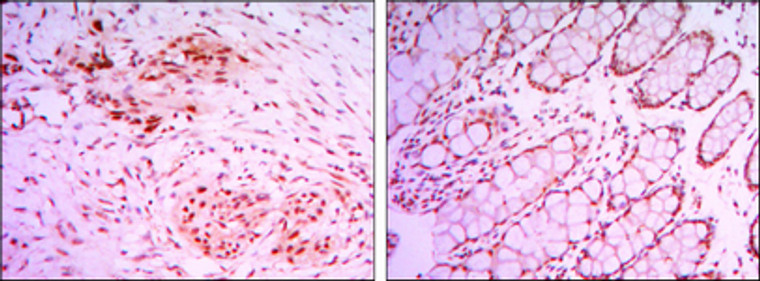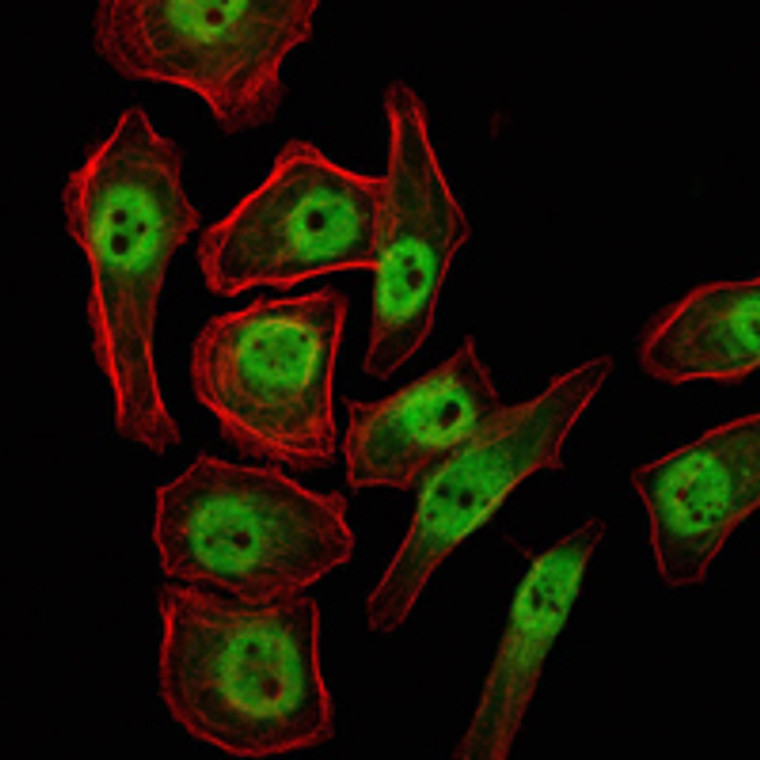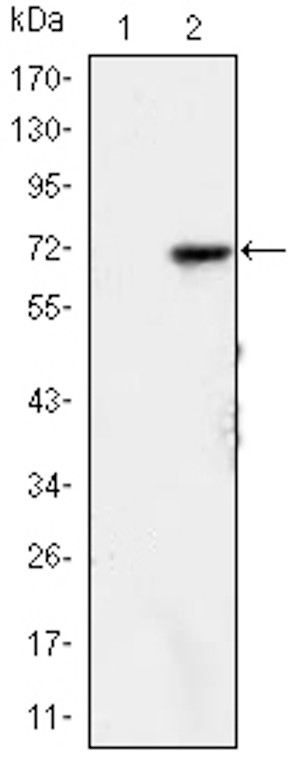| Host: |
Mouse |
| Applications: |
WB/IHC/IF/ELISA |
| Reactivity: |
Human |
| Note: |
STRICTLY FOR FURTHER SCIENTIFIC RESEARCH USE ONLY (RUO). MUST NOT TO BE USED IN DIAGNOSTIC OR THERAPEUTIC APPLICATIONS. |
| Short Description: |
Mouse monoclonal antibody anti-Lysine-specific demethylase 4A demethylase 4A demethylase 4A is suitable for use in Western Blot, Immunohistochemistry, Immunofluorescence and ELISA research applications. |
| Clonality: |
Monoclonal |
| Clone ID: |
5H1 |
| Conjugation: |
Unconjugated |
| Isotype: |
IgG1 |
| Formulation: |
Liquid in PBS containing 0.03% Sodium Azide, 0.5% BSA, 50% Glycerol. |
| Purification: |
Affinity purification |
| Dilution Range: |
WB 1:500-1:2000IHC 1:200-1:1000IF 1:200-1:1000ELISA 1:10000 |
| Storage Instruction: |
Store at-20°C for up to 1 year from the date of receipt, and avoid repeat freeze-thaw cycles. |
| Gene Symbol: |
KDM4A |
| Gene ID: |
9682 |
| Uniprot ID: |
KDM4A_HUMAN |
| Specificity: |
JMJD2A Monoclonal Antibody detects endogenous levels of JMJD2A protein. |
| Immunogen: |
Purified recombinant fragment of human JMJD2A expressed in E. Coli. |
| Post Translational Modifications | Ubiquitinated by RNF8 and RNF168 following DNA damage, leading to its degradation. Degradation promotes accessibility of H4K20me2 mark for DNA repair protein TP53BP1, which is then recruited. |
| Function | Histone demethylase that specifically demethylates 'Lys-9' and 'Lys-36' residues of histone H3, thereby playing a central role in histone code. Does not demethylate histone H3 'Lys-4', H3 'Lys-27' nor H4 'Lys-20'. Demethylates trimethylated H3 'Lys-9' and H3 'Lys-36' residue, while it has no activity on mono- and dimethylated residues. Demethylation of Lys residue generates formaldehyde and succinate. Participates in transcriptional repression of ASCL2 and E2F-responsive promoters via the recruitment of histone deacetylases and NCOR1, respectively. Isoform 2: Crucial for muscle differentiation, promotes transcriptional activation of the Myog gene by directing the removal of repressive chromatin marks at its promoter. Lacks the N-terminal demethylase domain. |
| Protein Name | Lysine-Specific Demethylase 4aJmjc Domain-Containing Histone Demethylation Protein 3aJumonji Domain-Containing Protein 2aHistone H3-Trimethyl-L-Lysine(36 Demethylase 4aHistone H3-Trimethyl-L-Lysine(9 Demethylase 4a |
| Database Links | Reactome: R-HSA-3214842Reactome: R-HSA-5693565Reactome: R-HSA-9029569 |
| Cellular Localisation | Nucleus |
| Alternative Antibody Names | Anti-Lysine-Specific Demethylase 4a antibodyAnti-Jmjc Domain-Containing Histone Demethylation Protein 3a antibodyAnti-Jumonji Domain-Containing Protein 2a antibodyAnti-Histone H3-Trimethyl-L-Lysine(36 Demethylase 4a antibodyAnti-Histone H3-Trimethyl-L-Lysine(9 Demethylase 4a antibodyAnti-KDM4A antibodyAnti-JHDM3A antibodyAnti-JMJD2 antibodyAnti-JMJD2A antibodyAnti-KIAA0677 antibody |
Information sourced from Uniprot.org
12 months for antibodies. 6 months for ELISA Kits. Please see website T&Cs for further guidance









